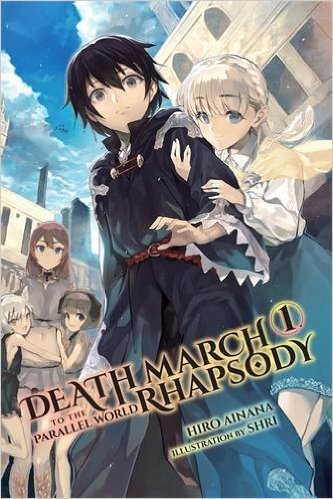By Hiro Ainana and shri. Released in Japan by Fujimi Shobo. Released in North America by Yen On. Translated by Jenny McKeon.
There is a bit of a cliche about the typical isekai hero. The abbreviation used, I believe is ‘OP’, as in ‘overpowered’. In fact, it gets applied to light novels heroes whether it’s an isekai or not, but generally tends to mean that the hero wins most of his fights with ease, has very little difficulty amassing a group of girls who like him, and wanders through the story being a cool wish-fulfillment character. Of course, when you examine the works more closely, no one here is ever QUITE that bad. Taking the two most obvious examples, Kirito has various issues in both his real and gaming life (which admittedly the author does not emphasize as much as he should), and Tatsuya has genuine issues communicating properly with people much of the time due to literally being engineered to not have strong emotions. Hell, even Arifureta’s hero spends almost half the book suffering as a bullied loser before he goes through hell and becomes Grimdark Araragi. And then there’s Death March’s Satou.
Even Satou’s very name, one of the most common last names in Japan, screams generic. The author seems to have this misguided opinion that being above the age of 25 somehow manages to let you control all your emotions perfectly, and so Satou strides through situations with barely a raised eyebrow. His briefly getting mildly annoyed at the villain at the end of this volume is a major breakthrough, something he even lampshades. Hell, you know the scene in KonoSuba where Kazuma goes through hell in order to get laid with a brothel employee only for everything to conspire against him? Here, Satou can simply go to a brothel, level up in many erotic ways (which he refuses to tell us), and suffer no punishment other than being briefly yelled at by his loli slave, who he spends most of the book chastising in any case. You could argue that Touya from Mixed Bathing and Touya from Isekai Smartphone are generic nice guys too, but at least they have normal reactions and are somewhat fresh-faced and shiny. Satou is “been there, done that”.
Oh yes, speaking of that loli, Arisa is the major new cast addition this time around, and is also from Japan, though we don’t know the details yet. Given her behavior, I suspect that she’s much older than her fantasy appearance here. But on that note, can we dial down Satou reminding us he’s not a lolicon just a bit? I realize he’s surrounded by young girls (most of whom he owns – the slavery aspect to this work is still very uncomfortable, especially as his reaction is along the lines of “well, that’s the way it is”) but it’s annoying given that the author clearly IS a lolicon and is happy to give us lots of service whether asked for or not. Other new characters include Arisa’s companion, who is painfully shy except when discussing Arisa, and also cursed to look ugly to everyone (except Satou), a generic mook villainess who is #7 of a group of eight, so is naturally named Nana by Satou because he is awful, and a cute realtor who seems to want to be ravished by her boss. Oh, and an elf princess, also very young.
Is there anything in this book that isn’t painful? The last third or so, where he’s battling his way up a huge tower full of monsters, shows the author can be decent when he’s writing fight scenes. At one point, Satou has to literally breakdance his way past the villains, the only time in the entire volume I laughed out loud. But for the most part, if you’re interested in an isekai published in North America, literally any other novel is better than this. Congrats, Death March, you’re the first light novel I’m dropping for simply being bad, rather than dark (Black Bullet, Goblin Slayer, Grimgar) or offensive (Siskan).



